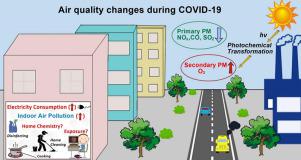Atmospheric Research ( IF 4.5 ) Pub Date : 2021-08-25 , DOI: 10.1016/j.atmosres.2021.105823 Max G Adam 1 , Phuong T M Tran 1, 2 , Rajasekhar Balasubramanian 1

|
In response to the rapid spread of coronavirus disease-2019 (COVID-19) within and across countries and the need to protect public health, governments worldwide introduced unprecedented measures such as restricted road and air travel and reduced human mobility in 2020. The curtailment of personal travel and economic activity provided a unique opportunity for researchers to assess the interplay between anthropogenic emissions of primary air pollutants, their physical transport, chemical transformation, ultimate fate and potential health impacts. In general, reductions in the atmospheric levels of outdoor air pollutants such as particulate matter (PM), nitrogen dioxide (NO2), carbon monoxide (CO), sulfur dioxide (SO2), and volatile organic compounds (VOCs) were observed in many countries during the lockdowns. However, the levels of ozone (O3), a secondary air pollutant linked to asthma and respiratory ailments, and secondary PM were frequently reported to remain unchanged or even increase. An increase in O3 can enhance the formation of secondary PM2.5, especially secondary organic aerosols, through the atmospheric oxidation of VOCs. Given that the gaseous precursors of O3 (VOCs and NOx) are also involved in the formation of secondary PM2.5, an integrated control strategy should focus on reducing the emission of the common precursors for the co-mitigation of PM2.5 and O3 with an emphasis on their complex photochemical interactions. Compared to outdoor air quality, comprehensive investigations of indoor air quality (IAQ) are relatively sparse. People spend more than 80% of their time indoors with exposure to air pollutants of both outdoor and indoor origins. Consequently, an integrated assessment of exposure to air pollutants in both outdoor and indoor microenvironments is needed for effective urban air quality management and for mitigation of health risk. To provide further insights into air quality, we do a critical review of scientific articles, published from January 2020 to December 2020 across the globe. Finally, we discuss policy implications of our review in the context of global air quality improvement.
中文翻译:

COVID-19 封锁期间城市空气质量变化:严格审查
为了应对 2019 冠状病毒病 (COVID-19) 在国家内部和国家之间的迅速传播以及保护公众健康的需要,世界各国政府在 2020 年采取了前所未有的措施,例如限制道路和航空旅行以及减少人员流动。个人旅行和经济活动为研究人员评估主要空气污染物的人为排放、其物理传输、化学转化、最终命运和潜在健康影响之间的相互作用提供了独特的机会。总体而言,室外空气污染物(例如颗粒物(PM)、二氧化氮(NO 2)、一氧化碳(CO)、二氧化硫(SO 2)和挥发性有机化合物(VOC))的大气水平有所下降许多国家在封锁期间。然而,据报道,臭氧(O 3)(一种与哮喘和呼吸系统疾病有关的二次空气污染物)和二次颗粒物的水平保持不变甚至增加。O 3的增加可以通过大气氧化VOC来增强二次PM 2.5的形成,特别是二次有机气溶胶。鉴于O 3的气态前体(VOCs和NO x )也参与二次PM 2.5的形成,综合控制策略应侧重于减少常见前体的排放,以共同缓解PM 2.5和O 3重点是它们复杂的光化学相互作用。与室外空气质量相比,室内空气质量(IAQ)的综合调查相对较少。人们 80% 以上的时间都在室内度过,接触室外和室内的空气污染物。因此,需要对室外和室内微环境中的空气污染物暴露进行综合评估,以实现有效的城市空气质量管理和减轻健康风险。为了进一步了解空气质量,我们对 2020 年 1 月至 2020 年 12 月全球范围内发表的科学文章进行了严格审查。最后,我们讨论了我们的审查在全球空气质量改善背景下的政策影响。











































 京公网安备 11010802027423号
京公网安备 11010802027423号